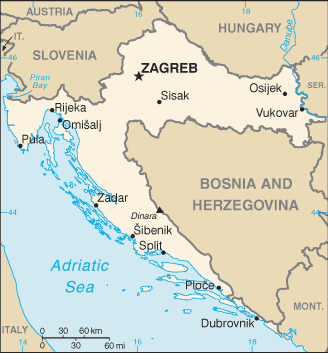Europe > Croatia: Weather, Map, Costs and Travel Guide

Croatia : When and where to go?
Click on a city for complete climate and weather tables
Croatia: Climate & Weather
The country is divided into two parts; each has a fairly different climate: the internal part is characterized by a continental climate with a cold winter and snowfall as well as freezing temperatures and very hot summers with storms.
The coastal part has a Mediterranean climate with temperate winters and warm, dry summers and a sea temperature of 26°C in summer.
The winds, the Bora from the north-east and the Jugo from the south, may change these general trends.
The best time to visit Croatia is between May and September, apart from the months of July and August when heavy crowds, both local and foreign, arrive at the coast.
Weather today

Partly Cloudy
Wind: 2 km/h
Precipitation forecast: 0 mm
> Full report and 7-days forecast
Data updated at 12:32 (local time)
At that time, the weather was:
 8 °C / Partly Cloudy
8 °C / Partly Cloudy
Croatia: Map

Sponsored links
What to do in Croatia
The capital, Zagreb, offers many attractions: The Cathedral, the Croatian Museum of Natural History, Saint Marc’s Church, the Arts Pavilion, the Mimara Museum and the beautiful mausoleums of Mirogoj Cemetery are just a few examples.
The old city of Dubrovnik, surrounded by walls, will seduce you as well: The beautiful stone used in its construction can be found in the houses, fountains, squares and palaces. You can stroll on the Placa, a promenade for pedestrians only, visit the museum of the Franciscan Monastery, admire the St. Blaise Church and relax on Lokrum Island, classified as a National Park, that you can reach by ferry.
Split also has a lovely old city which boasts wonders like Diocletian's Palace, the Archaeological Museum and the Mestrovic Gallery! Nearby, a beautiful beach is waiting for you after your cultural visits.
Korcula Island is a worthy place to visit: Vineyards, charming coves, olive groves, but also the city with its typical red roofs, making it an attractive and serene destination.
Croatia: The basics
Zagreb is connected with various cities throughout Europe by several airlines.
EU citizens do not require a visa.
The currency in circulation is the Kuna.
The budget required is reasonably moderate, but prices rise in July and August, as well as in the capital and some popular touristic areas: An average meal, generally copious and delicious, costs less than €20, and a double room normally costs less than €70.
To travel around the country, the buses are quite efficient and cheap. The train is slower but more comfortable. Ferries also connect Islands in the Adriatic to the continent, and between some of the islands themselves and they are an enjoyable way to discover parts of the country.
There are no health issues in Croatia, and the health system is quite effective and provides good quality health care.







